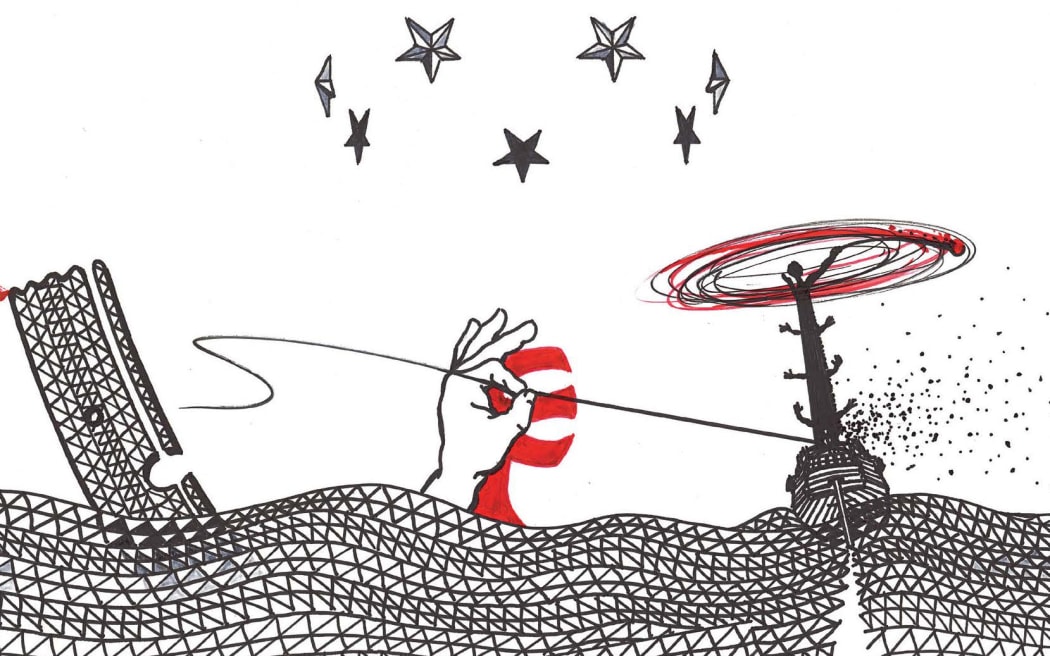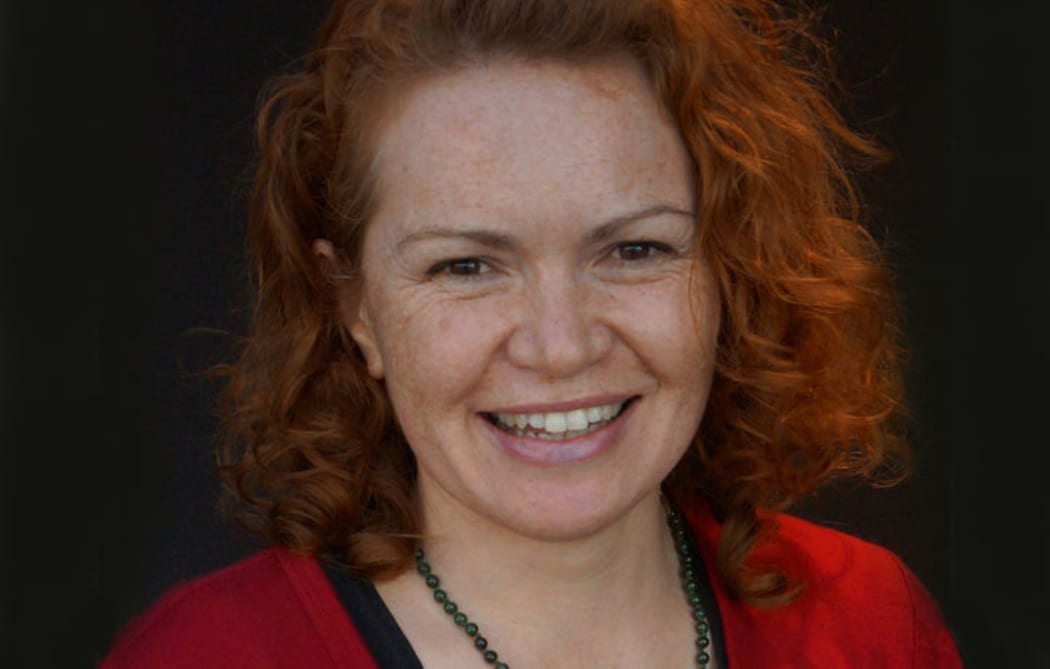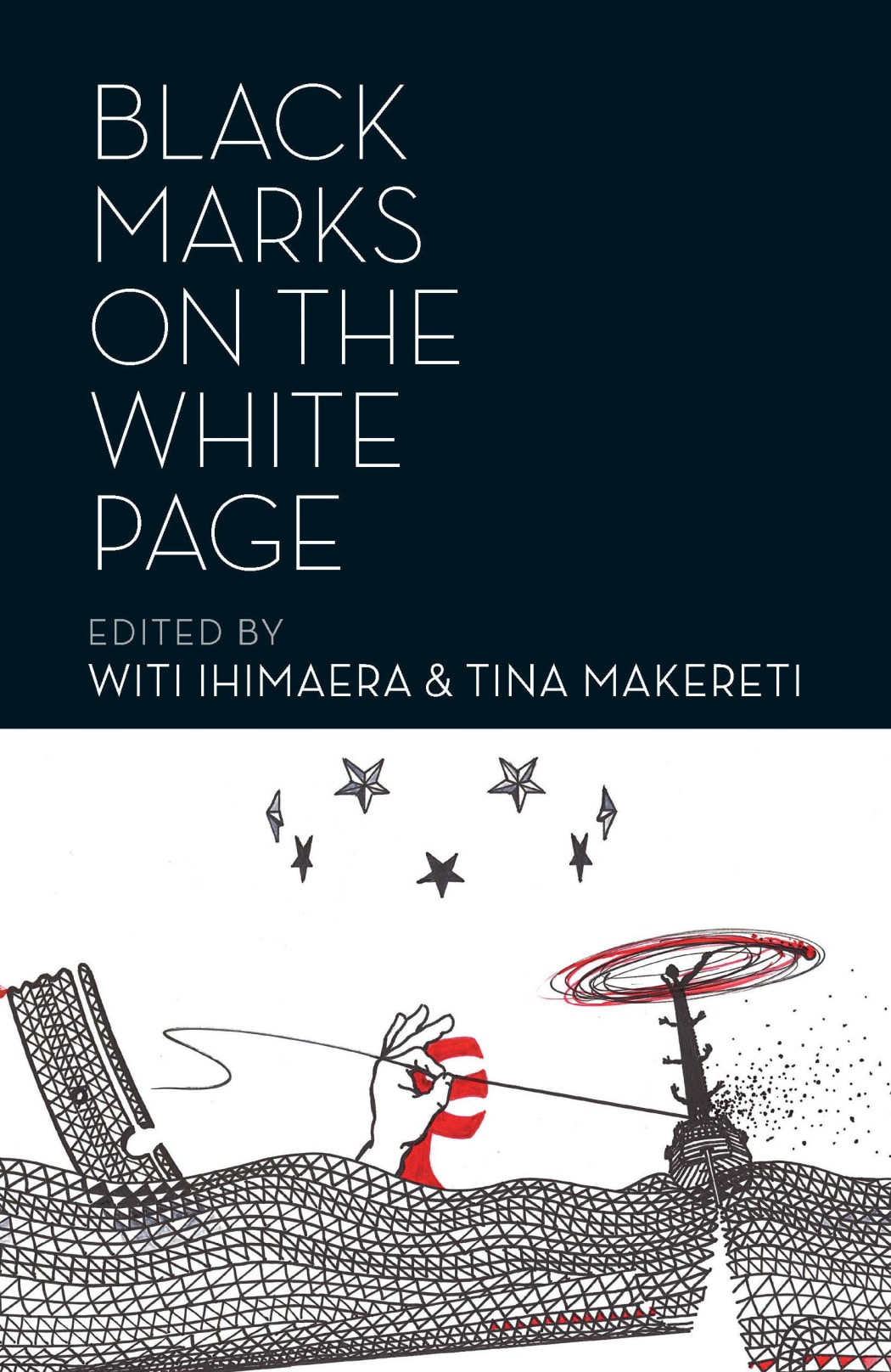A new collection of writing creates a conversation about kinship across the Pacific.

Cover art from Black Marks on a White Page. Photo: Illustration: James Ormsby
Black Marks on a White Page, a new anthology of writing edited by Tina Makereti and Witi Ihimaera, looks to expand preceptions of the Pacific world.
The book includes new work and excerpts from the likes of Courtney Sina Meredith, Patricia Grace, Gina Cole, Tusiata Avia, and Victor Rodger. As well as Māori and Pasifika writers, it also includes guest work from Aboriginal Australian writer Alexis Wright, and several visual artists whose work speaks to similar kaupapa.
I spoke to Tina about her vision for the book.

Black Marks on a White Page co-editor Tina Makereti. Photo: Supplied
Tēnā koe e te kaituhi, Tina Makereti.
First thing I wanted to say is that I am on a bit of a journey at the moment to try and only read Māori and Pasifika authors, so it’s always exciting and liberating to access a wide collection of our people’s words. What kind of authors did you bring in and why?
That’s brilliant. We wanted to survey who is actually writing right now and what kind of writing they’re doing. We were both aware that this hadn’t been done for a while. In fact it hadn’t been done since Witi’s last anthology, Get On The Waka, though that included Māori writers only.
We wanted to focus on fiction, because that is our field, and that is the field we recognised as most neglected since Robert Sullivan, Reina Whaitiri and Albert Wendt have been doing excellent work anthologising Māori and Pasifika poetry.
We were looking for innovation too. For me, Māori and Pasifika writing and arts is the most exciting and innovative and edgy thing happening and we wanted to capture a sense of that. We weren’t disappointed. Finally, we wanted the book to be pan-Pacific.
We took guidance from other Māori and Pacific literature scholars in this. The conversation that Māori and Pacific scholars are having is around the Pacific as an Oceanic continent, as a superhighway since ancient times. When you begin to see the ocean as connective rather than separating, it becomes more difficult to put ourselves into separate groups.
Politically, I think Māori are moving forward from the urgent land claim era that came before treaty "settlements" began. I’m not saying that land claims aren’t important (or still urgent), but that maybe we have a new confidence about the whenua under our feet, which means we can look again to our kinships across the Pacific.
Those kinships have never gone away, but there was a time when it was politically expedient to make our separate claims. I think it’s creatively expedient now to return to unity and kinship, particularly when we understand our identities primarily in a global, digital world, and particularly when we understand that whatever happens to the Pacific environmentally, also happens to us.
Do you think writers from this generation are thinking differently to the previous generation of Polynesian peoples?
Yes – there are a few conflicting yet co-existing things in play. I’ve named some of them above. Many more of us are of mixed descent and are looking at the world through multiple lenses. It was good working with Witi on this because I very much come from the multiple lense perspective and he comes from that generation earlier when it made sense to make specific claims about Māori identity, and both these things are true. We have to get comfortable with being many things at once – our communities are many things at once: local/global/Māori/Pākehā/Pacific (in all its rich, multiple manifestations)/queer/straight (and everything in between)/every gender.
In a way Oceania, or the Pacific, is the perfect metaphor for this.I always think of Albert Wendt’s ‘Towards a New Oceania’, (which is from 1976, so maybe none of this is anything new, though maybe Albert was just before his time): “So vast, so fabulously varied a scatter of islands. nations, cultures, mythologies and myths, so dazzling a creature, Oceania deserves more than an attempt at mundane fact; only the imagination in free flight can hope - if not to contain her - to grasp some of her shape, plumage, and pain.”
The book does this job of trying to grasp Oceania by questioning boundaries passed to us by colonisation and by dominant culture, right down to whether genre and form matters.
Obviously the title immediately brings up connotations of colonisation and inter-cultural interactions. Tell me a bit more about that title. Why Black Marks on the White Page?
It really came from my frustration at not seeing enough writing from our communities. Words on a page. Black Marks on the White Page. I had the phrase long before I understood the connotations. Once I shared it with Witi the multiple meanings just kept coming.
What I love about it is that it encapsulates everything we want to say: we want to see more of our words on the page, we want to disrupt what has been a predominantly white page, we want to blacken things up, so to speak. In a way that’s alarming and transgressive because we tend to avoid words like black and white in New Zealand when we’re talking about ethnicity.
We have this smug sense of being a more integrated country, more racially harmonious. That seems true until you notice that the overwhelming majority of our published literature comes from only one culture and ethnicity.
You keep digging down into that and it’s clear where many of the educational and therefore income and health disparities come from. Then there are the further connotations of black marks being some kind of negative thing used against us, and if you go deeper, there’s a long history of both loving and being hurt by words on pages.
Māori writers such as yourself, such as Witi, and many others have been pushing that Māori voice in the literature space for decades now. There are all these big topics within te ao Māori and the wider Pacific that we read about often. Disconnection, tīpuna, migration, interaction with the colonizer.
What are the big themes in this collection? And how are contemporary writers creating intricacies within those big themes?
There is a wide variety of themes and subjects in Black Marks, and that was intentional, but it was also what we were presented with: the diversity and variety within our communities. There’s definitely an engagement with politics, with family and trauma, with sexualities and sex, with speculative fiction and experimentation, with spirituality and culture.
But what all these stories have in common is that they’re examining our lives, the lives of Indigenous Peoples of the Pacific, from the inside, and asking “What if?” – creatively engaging with our realities. The intricacies are that we all go about this in our own ways – the specificities of our stories are so distinct.
So we get Anahera Gildea writing in a collective tipuna voice, Patricia Grace writing eloquent prose in the voice we know and love, David Geary throwing a formally experimental tale about state surveillance at us and Nic Low putting us in post-Facebook world. And that’s just four stories out of nearly 30.
I really liked what you said to Kathryn Ryan on RNZ about how you have mixed feelings where you are trying to acknowledge the “richness” of our writer’s voices, whilst also trying to acknowledge how little validation there is of Māori and Pasifika publishing.
Obviously we have our own spaces where it is not challenging to express indigenous voice, but how do you find the challenge of pushing our voice, our tikanga, our ideas in mainstream spaces?
Well the funny thing is, I can play with this idea of “black” and “white”, but that’s not how I exist in the world. I walk between two worlds every day, and it’s taken me a long time, but I’m pretty comfortable knowing I come from both (this is different from, say, the person who is strongly from one culture, but forced to walk in two cultural worlds simply due to the process of colonisation).

Photo: Image: Penguin NZ
This is a gift from my predominantly Pākehā, and fairly racist, upbringing. I was angry about that upbringing for a long time, but it gave me the gift of being able to walk between these spaces and be a bit noisy in the mainstream spaces because I’m comfortable there, yet at the same time I can see what’s missing.
Sometimes I get people’s ignorances from the inside because they’re really familiar to me. I don’t understand them but I think maybe I see them for what they are. What I’m getting to here is that the particular thing I was given from that upbringing is the ability to be a cultural translator.
That can be exhausting, but I suspect it is less exhausting for me than it is for most Māori. I suspect most of the time people just can’t see or hear what they’re unfamiliar with. I’m interested in finding new ways to get under their skin.
Selina Tusitala Marsh recently said she’d been described as “the smiling assassin” and I think many of my role models have been that way. But also at a certain point I don’t care – I don’t mind being the person asking the naïve questions, or pointing out a problem. It can be really painful but I understand my being comfortable in those spaces is due to a certain amount of privilege – that others don’t find it so easy.
It is exciting to see the inclusion not just of Māori work, but work from wider Pasifika writers. I think there is a lot of strength in creating symmetry with our whanaunga and reflecting an identity that crosses the boundaries of land and enters the sea.
Where do you see this relationship moving in the future, and how does it excite you?
Our Pasifika brothers and sisters just astound me. I remember when I first learnt about the va and the talanoa. I love these concepts. Māori have similar concepts (I always think of creativity being sourced from Te Kore) but none quite the same and I wonder why. I also wonder why we don’t have drums, haha! But I think if your creative world is sourced from the va, that if you express yourself through the talanoa, then you’re already working with fluidity and multiplicity, dark and light, going beyond boundaries, and that’s where the real juice is, and that’s why the creative movements coming out of South Auckland, like FAFSWAG and South Auckland Poets Collective, and Kava Club here in Welly, are so exciting. They’re inclusive of Māori but they have a Pacific heart. I’m taking my cues from them.

